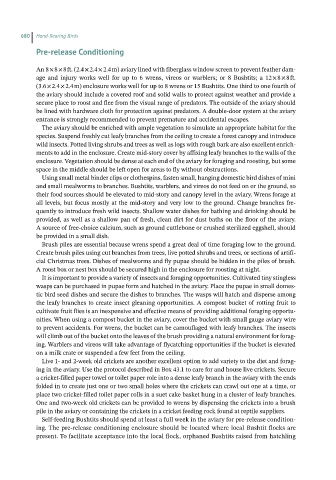Page 679 - Hand rearing birds second
P. 679
680 Hand-Rearing Birds
Pre-releaseConditioning
An 8 × 8 × 8 ft. (2.4 × 2.4 × 2.4 m) aviary lined with fiberglass window screen to prevent feather dam-
age and injury works well for up to 6 wrens, vireos or warblers; or 8 Bushtits; a 12 × 8 × 8 ft.
(3.6 × 2.4 × 2.4 m) enclosure works well for up to 8 wrens or 15 Bushtits. One third to one fourth of
the aviary should include a covered roof and solid walls to protect against weather and provide a
secure place to roost and flee from the visual range of predators. The outside of the aviary should
be lined with hardware cloth for protection against predators. A double‐door system at the aviary
entrance is strongly recommended to prevent premature and accidental escapes.
The aviary should be enriched with ample vegetation to simulate an appropriate habitat for the
species. Suspend freshly cut leafy branches from the ceiling to create a forest canopy and introduce
wild insects. Potted living shrubs and trees as well as logs with rough bark are also excellent enrich-
ments to add in the enclosure. Create mid‐story cover by affixing leafy branches to the walls of the
enclosure. Vegetation should be dense at each end of the aviary for foraging and roosting, but some
space in the middle should be left open for areas to fly without obstructions.
Using small metal binder clips or clothespins, fasten small, hanging domestic bird dishes of mini
and small mealworms to branches. Bushtits, warblers, and vireos do not feed on or the ground, so
their food sources should be elevated to mid‐story and canopy level in the aviary. Wrens forage at
all levels, but focus mostly at the mid‐story and very low to the ground. Change branches fre-
quently to introduce fresh wild insects. Shallow water dishes for bathing and drinking should be
provided, as well as a shallow pan of fresh, clean dirt for dust baths on the floor of the aviary.
A source of free‐choice calcium, such as ground cuttlebone or crushed sterilized eggshell, should
be provided in a small dish.
Brush piles are essential because wrens spend a great deal of time foraging low to the ground.
Create brush piles using cut branches from trees, live potted shrubs and trees, or sections of artifi-
cial Christmas trees. Dishes of mealworms and fly pupae should be hidden in the piles of brush.
A roost box or nest box should be secured high in the enclosure for roosting at night.
It is important to provide a variety of insects and foraging opportunities. Cultivated tiny stingless
wasps can be purchased in pupae form and hatched in the aviary. Place the pupae in small domes-
tic bird seed dishes and secure the dishes to branches. The wasps will hatch and disperse among
the leafy branches to create insect gleaning opportunities. A compost bucket of rotting fruit to
cultivate fruit flies is an inexpensive and effective means of providing additional foraging opportu-
nities. When using a compost bucket in the aviary, cover the bucket with small gauge aviary wire
to prevent accidents. For wrens, the bucket can be camouflaged with leafy branches. The insects
will climb out of the bucket onto the leaves of the brush providing a natural environment for forag-
ing. Warblers and vireos will take advantage of flycatching opportunities if the bucket is elevated
on a milk crate or suspended a few feet from the ceiling.
Live 1‐ and 2‐week old crickets are another excellent option to add variety to the diet and forag-
ing in the aviary. Use the protocol described in Box 43.1 to care for and house live crickets. Secure
a cricket‐filled paper towel or toilet paper role into a dense leafy branch in the aviary with the ends
folded in to create just one or two small holes where the crickets can crawl out one at a time, or
place two cricket‐filled toilet paper rolls in a suet cake basket hung in a cluster of leafy branches.
One and two‐week old crickets can be provided to wrens by dispensing the crickets into a brush
pile in the aviary or containing the crickets in a cricket feeding rock found at reptile suppliers.
Self‐feeding Bushtits should spend at least a full week in the aviary for pre‐release condition-
ing. The pre‐release conditioning enclosure should be located where local Bushtit flocks are
present. To facilitate acceptance into the local flock, orphaned Bushtits raised from hatchling

